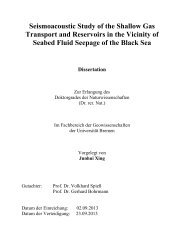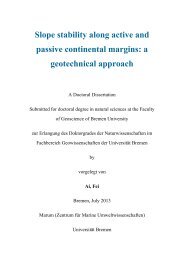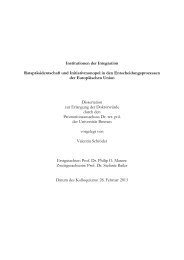aus dem MARUM und dem Fachbereich Geowissenschaften der ...
aus dem MARUM und dem Fachbereich Geowissenschaften der ...
aus dem MARUM und dem Fachbereich Geowissenschaften der ...
You also want an ePaper? Increase the reach of your titles
YUMPU automatically turns print PDFs into web optimized ePapers that Google loves.
MARIA S. MERIAN-Berichte, Cruise 20, Leg 4, Bridgetown – Freeport, 15.3.2012 – 7.4.2012<br />
West- to Southwest-Florida Slope, in the Florida Straits and along the Great Bahama Bank.<br />
Moreover, we wanted to get an overview of the variability of water masses in the ultimate vicinity of<br />
these CWC habitats in space (locally-regionally) and time (tidal cycles). Bottom water samples were<br />
taken at all localities to get an overview of the geochemical characteristics of these water masses. In<br />
addition, so<strong>und</strong> velocity data were provided for hydroacoustic mapping (see chapter 5.2.3).<br />
5.3.2 Sampling and methods<br />
The CTD profiler used during MSM 20-4 was a Seabird "SBE 9 plus" <strong>und</strong>erwater unit and a<br />
Seabird "SBE 11plus V2" deck unit. Additionally, it was equipped with two dissolved oxygen<br />
sensors, a chlorophyll-a sensor and a Seabird bottle release unit including a rosette water sampler.<br />
For the analysis and interpretation of the measurements, the downcast raw data were processed<br />
with "SBE Data Processing" software. For the visualisation of the data we used "Ocean Data View<br />
(mp-Version 3.3.2)". Measured O2 values were verified by using the Winkler titration method<br />
(Winkler, 1888). We performed single casts, one transect, and three Yoyo-CTDs with repeated casts<br />
over 13 hours covering one complete tidal cycle. A total of 49 CTD profiles were measured during<br />
the cruise. In addition, we received bottom water samples collected during the ROV dives in close<br />
vicinity to living CWC.<br />
5.3.3 Shipboard Analyses<br />
5.3.3.1 Seawater Oxygen Analyses<br />
The measurements of the CTD oxygen sensors were validated on board with water samples by<br />
iodometric WINKLER-Titration after Grasshoff (1983). The measurements were performed on<br />
all 49 CTD casts. Water samples were taken during upcasts only. When a designated sampler<br />
bottle was released, the oxygen sensor readings were noted and later compared to the titration<br />
results. Immediately after collection, the water samples were filled into volume-calibrated<br />
WINKLER-bottles. Two parallel samples were taken, and we paid particular attention of not<br />
having any air in the WINKLER-bottles. The oxygen was fixed with 0.5 cm 3 manganese-IIchloride<br />
and 0.5 cm 3 alkaline iodide. Then the bottles were shaken and stored cool for several<br />
hours. Before titration, the manganese hydroxide was solved with 1 cm 3 H2SO4 (9M) and the<br />
bottles were shaken again. The samples were each transferred into a 250 ml beaker, where they<br />
were titrated with 0.02 M sodium thiosulfate until the solution turned into yellow. After adding<br />
1 cm 3 of zinc iodide solution, the titration was continued until the blue colour of the sample<br />
disappeared. The factor of the thiosulfate solution was determined with a standard, which was<br />
performed after each CTD station. The oxygen content was calculated from the thiosulfate<br />
consumption by using the following standard formula:<br />
O2 = (a * f * 0.112 * 103) / (b-1) [ml/l]<br />
where a is the consumption of thiosulfate solution [ml], b is the volume of the WINKLER bottle<br />
[ml], and f is the factor of the thiosulfate solution. A total number of 42 titrations were performed.<br />
The oxygen contents range from 5.14 to 2.42 ml/l. The accuracy of our titrations is 0.5%, which is<br />
in the range of values reported in the literature (0.06 to 0.89 %; Furuya & Harda, 1995). The two<br />
oxygen sensors of the CTD, however, recorded different oxygen contents at shallow depths (

















